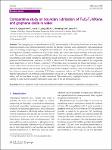Item Infomation
Full metadata record
| DC Field | Value | Language |
|---|---|---|
| dc.contributor.author | Wei, Sun | - |
| dc.contributor.author | Qingrui, Song | - |
| dc.contributor.author | Kun, Liu | - |
| dc.date.accessioned | 2023-04-18T07:59:33Z | - |
| dc.date.available | 2023-04-18T07:59:33Z | - |
| dc.date.issued | 2023 | - |
| dc.identifier.uri | https://link.springer.com/article/10.1007/s40544-022-0672-z | - |
| dc.identifier.uri | https://dlib.phenikaa-uni.edu.vn/handle/PNK/8042 | - |
| dc.description | CC BY | vi |
| dc.description.abstract | The emerging use of two-dimensional (2D) nanomaterials as boundary lubricants in water offers numerous benefits over oil-based lubricants; whereas the friction reduction varies significantly with nanomaterial type, size, loading, morphology, etc. Graphene oxide (GO) and Ti3C2Tx MXene, a relatively new 2D material, are investigated as boundary lubricants in water in this study. The contact pair mainly includes Si3N4 balls and Si wafer. The results found (1) monodispersed GO offers better lubricity than monodispersed MXene under identical concentration and testing conditions; and (2) the mixed dispersion of GO and MXene (0.1 mg/ml: 0.1 mg/ml) produced the lowest friction coefficient of ∼ 0.021, a value 4× and 10× lower than that produced by comparable mono-dispersions of GO or MXene, respectively. | vi |
| dc.language.iso | en | vi |
| dc.publisher | Springer | vi |
| dc.subject | emerging use of two-dimensional | vi |
| dc.subject | Graphene oxide (GO) and Ti3C2Tx MXene | vi |
| dc.title | Comparative study on boundary lubrication of Ti3C2Tx MXene and graphene oxide in water | vi |
| dc.type | Book | vi |
| Appears in Collections | ||
| OER - Kỹ thuật điện; Điện tử - Viễn thông | ||
Files in This Item:

